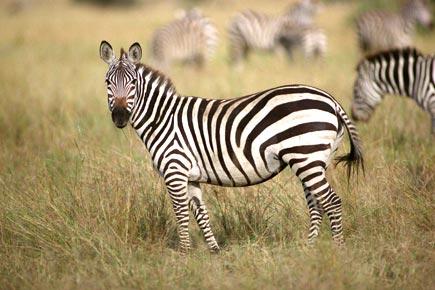Go tell this to your kids that the great riddle about black and white stripes on zebra has finally been solved. According to researchers at University of California (UC), Davis, biting flies, including horseflies and tsetse flies, are the evolutionary driver for zebra's stripes

New York: Go tell this to your kids that the great riddle about black and white stripes on zebra has finally been solved.
According to researchers at University of California (UC), Davis, biting flies, including horseflies and tsetse flies, are the evolutionary driver for zebra's stripes.
ADVERTISEMENT

Picture of a Zebra used for representational purposes
“I was amazed by our results. Again and again, there was greater striping on areas of the body in those parts of the world where there was more annoyance from biting flies,” said lead author Tim Caro, a UC Davis professor of wildlife biology.
Experimental work had previously shown that such flies tend to avoid black-and-white striped surfaces.
The team mapped the geographic distributions of the seven different species of zebras, horses and asses, and of their subspecies, noting the thickness, locations and intensity of their stripes on several parts of their bodies.
Their next step was to compare these animals' geographic ranges with different variables, including woodland areas, ranges of large predators, temperature, and the geographic distribution of glossinid (tsetse flies) and tabanid (horseflies) biting flies.
They then examined where the striped animals and these variables overlapped.
After analyzing these hypotheses, the scientists ruled out all but one: avoiding blood-sucking flies.
While the distribution of tsetse flies in Africa is well known, the researchers did not have maps of tabanids (horseflies, deer flies).
They found that striping is highly associated with several consecutive months of ideal conditions for tabanid reproduction.
Why would zebras evolve to have stripes whereas other hooved mammals did not?
The study found that unlike other African hooved mammals living in the same areas as zebras, zebra hair is shorter than the mouth-part length of biting flies, so zebras may be particularly susceptible to annoyance by biting flies, Caro noted.
“No one knew why zebras have such striking colouration. But solving evolutionary conundrums increases our knowledge of the natural world and may spark greater commitment to conserving it,” he commented.
But why do biting flies avoid striped surfaces?
“Now the debate can move from why zebras have stripes to what prevents biting flies from seeing striped surfaces as potential prey, and why zebras are so susceptible to biting fly annoyance,” Davis suggested in a paper published in the online journal Nature Communications.
 Subscribe today by clicking the link and stay updated with the latest news!" Click here!
Subscribe today by clicking the link and stay updated with the latest news!" Click here!







